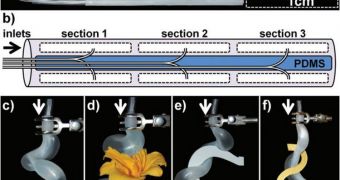The engineers who created the first robotic arms did not have subtlety and finesse in mind. They created the devices to work on factory assembly line, and did not have plans to use them from gentler applications. This shortcoming was finally addressed by a team of experts in the United States.
Scientists at the Harvard University have just announced the development of a new type of tentacle-like robotic arm, which they say is capable of lifting a flower without utterly crushing it. This means that it could be used for a variety of applications that were until now closed off to robots.
Manipulating small and fragile objects is becoming an increasingly present necessity in labs around the world. But scientists can't very well use industrial robots to perform tasks that require tweezers.
The instrument the Harvard team created is capable of doing just that. Researchers published a paper on how the system functions in the September 7 issue of the top scientific journal Advanced Materials.
The work is entitled “Robotic Tentacles with Three-Dimensional Mobility Based on Flexible Elastomers.”
The work was carried out together with researchers from the US Department of Energy (DOE) and the Defense Advanced Research Projects Agency (DARPA), the covert research arm of the Pentagon.
Taking inspiration from the latest soft robotic hands, the new instrument is similar to an octopus' tentacle. It can wrap itself around an object, touching different parts at the same time. It then applies pressure gently, enough to handle the item without dropping it.
The most important component of the new system is a single plastic flexible tube, which is filled with channels that can be pumped full of air. Each channel is operated individually, the team explains.
By applying various air pressures in each channel, it is possible to make the entire appendage move in a certain direction, curl, and exert pressure according to specifications. In addition, extracting all air from the tiny tubes reduces the overall volume of the arm, enabling it to be stored easily.
Previous generations of curling robotic arms could only move in a single dimension. The new instrument is capable of moving freely, wherever its operators want it to, PhysOrg reports.

 14 DAY TRIAL //
14 DAY TRIAL //